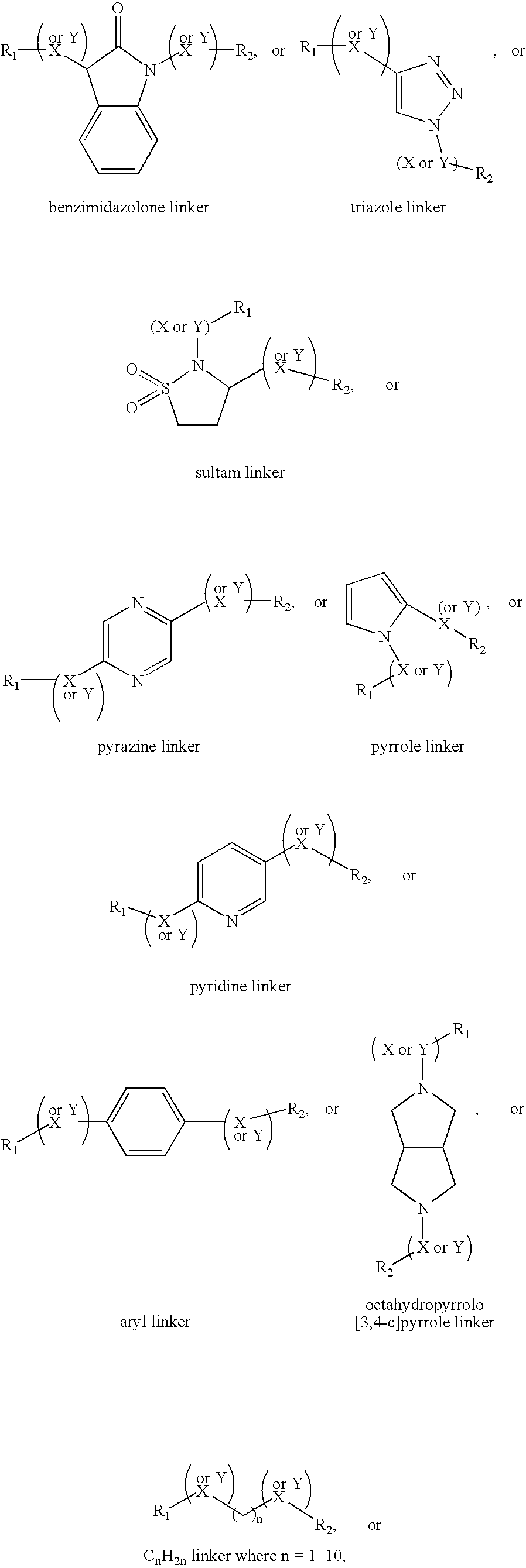Compositions and methods comprising proteinase activated receptor antagonists
a technology of activated receptors and antagonists, which is applied in the field of compositions and methods comprising proteinase activated receptor antagonists, can solve the problems of abnormal response and relatively uncontrolled division, and achieve the effect of minimal side effects
- Summary
- Abstract
- Description
- Claims
- Application Information
AI Technical Summary
Benefits of technology
Problems solved by technology
Method used
Image
Examples
example 1
PAR Signalling Activity
[0130] Confluent HUVECs, Lewis lung carcinoma cells or U87-MG glioma cells or HT29 colon carcinoma cells were loaded for 30-60 minutes with the fluorescent dye Fluo-4. Final concentration 4 uM Fluo-4, 0.02% pluronic acid in physiological buffer. Cells were then washed with assay buffer, (HBSS containing 1 mM CaCl2, 1 mM MgSO4, and 2.5 mM probenecid). Cells were stimulated with various doses of PAR-2 activating peptide, PAR-1 activating peptide or ATP. Fluorescence was monitored using a Wallac 1470 fluorescent plate reader. (See Al-ani et. al Journal of Pharmacology and Experimental Therapeutics 290:2, 753-760)
[0131] Calcium mobilization curves of the PAR-2 agonist SLIGKV (ENMD-1003) (SEQ ID NO:52) compared with two truncated molecules LIGK (ENMD-1005) (SEQ ID NO:1) and LIGKV (ENMD-1007) (SEQ ID NO:2) are provided in FIG. 2A. Neither truncated molecule was able to induce calcium mobilization, in contrast with SLIGKV (ENMD-1003) (SEQ ID NO:52), which demonstra...
example 2
Identification and Testing of PAR-2 Antagonists
[0132] In order to assess the potential of peptides and molecules selected above to block PAR-2 signaling, cells were pretreated with potential antagonist peptides for a predetermined amount of time and were subsequently treated with various GPCR agonists. Confluent Lewis lung carcinoma (LLC) cells were loaded for 30-60 minutes with the fluorescent dye Fluo-4. Final concentration 4 uM Fluo-4, 0.02% pluronic acid in physiological buffer. Cells were then washed with assay buffer, (HBSS containing 1 mM CaCl2, 1 mM MgSO4, and 2.5 mM probenecid). Cells were stimulated with various doses of PAR-2 activating peptide, PAR-1 activating peptide or ATP. Fluorescence was monitored using a Wallac 1470 fluorescent plate reader. (See Al-ani et. al Journal of Pharmacology and Experimental Therapeutics 290:2, 753-760). Additional compound screening was performed using U87-MG human glioma cells. In this assay cells were labeled with FLIPR Calcium 3 dye ...
example 3
Activation Study for Assessing Inhibitory Activity of LIGK (ENMD-1005) (SEQ ID NO:1) using ATP and SFLLRN (ENMD-1014) (SEQ ID NO:56)
[0135] In order to demonstrate that LIGK (ENMD-1005) (SEQ ID NO:1) is a specific inhibitor of PAR-2 signaling, activation studies were performed with ATP and the PAR-1 activation peptide, SFLLRN (ENMD-1014) (SEQ ID NO:56), on cells that were pretreated with LIGK (ENMD-1005) (SEQ ID NO:1). Both of these molecules signal through GPCRs, and PAR-1 is highly homologous to PAR-2, to the degree that the PAR-1 agonist peptide can signal through PAR-2 at high concentrations. In both cases, the PAR-2 antagonist LIGK (ENMD-1005) (SEQ ID NO:1) had no inhibitory effect on signaling (FIG. 5).
PUM
| Property | Measurement | Unit |
|---|---|---|
| concentration | aaaaa | aaaaa |
| total volume | aaaaa | aaaaa |
| volume | aaaaa | aaaaa |
Abstract
Description
Claims
Application Information
 Login to View More
Login to View More - R&D
- Intellectual Property
- Life Sciences
- Materials
- Tech Scout
- Unparalleled Data Quality
- Higher Quality Content
- 60% Fewer Hallucinations
Browse by: Latest US Patents, China's latest patents, Technical Efficacy Thesaurus, Application Domain, Technology Topic, Popular Technical Reports.
© 2025 PatSnap. All rights reserved.Legal|Privacy policy|Modern Slavery Act Transparency Statement|Sitemap|About US| Contact US: help@patsnap.com



